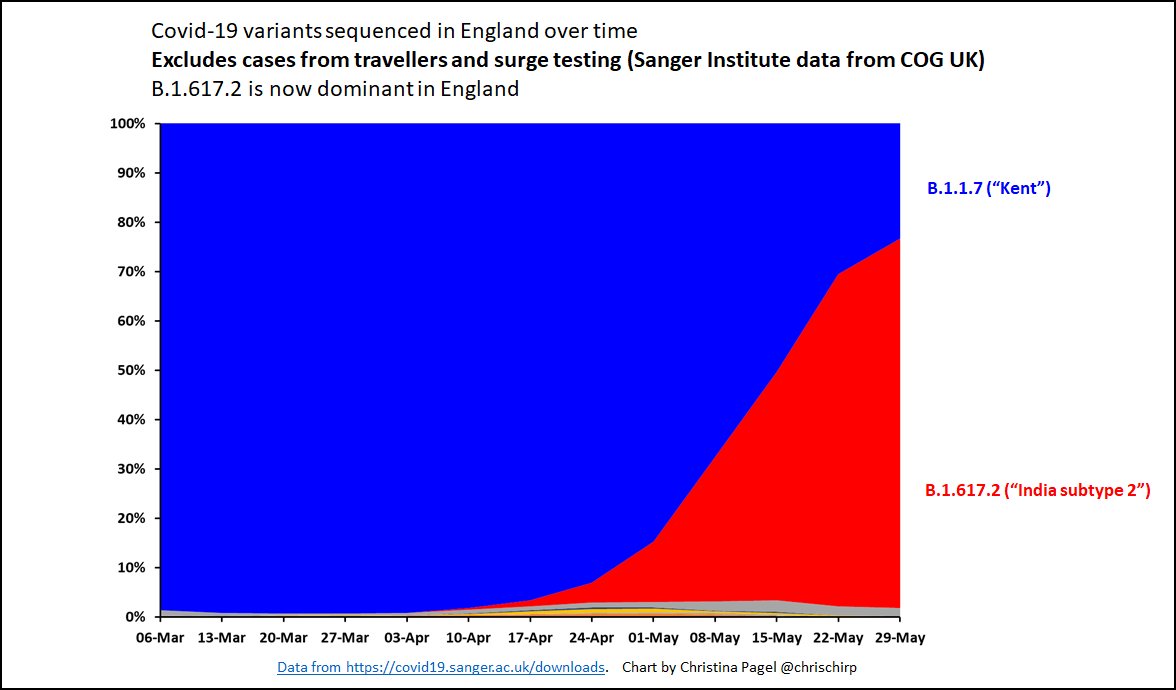
THREAD Some back of the envelope examples about how things could get difficult even with vaccination.
This is *no* replacement for the proper SAGE Spi-M models but gives you the idea. (11 tweets)
This is *no* replacement for the proper SAGE Spi-M models but gives you the idea. (11 tweets)
Between Oct & early Jan there were about 2.3 million confirmed cases of Covid, 135K hospital admissions & 28K deaths. Hardly anyone was vaccinated.
If we had a similar situation now but WITH vaccination then cases would be lower & admissions (~25K) & deaths (~3K) MUCH lower.
If we had a similar situation now but WITH vaccination then cases would be lower & admissions (~25K) & deaths (~3K) MUCH lower.

I think this is what most people have in their minds when they don't believe it could get bad this summer.
And if cases on same or lower scale then that is true - vaccination (particularly of vulnerable) protects us & the NHS.
And if cases on same or lower scale then that is true - vaccination (particularly of vulnerable) protects us & the NHS.
BUT we are not in the same situation virus wise.
We have a variant that is more transmissible (so spreads faster) and fewer restrictions than we've had since the start (no local hotspots restrictions).
We have a variant that is more transmissible (so spreads faster) and fewer restrictions than we've had since the start (no local hotspots restrictions).
B.1.617.2 (our new dominant variant) is increasing exponentially - still doubling every week.
If this continues, then cases can increase very fast.
It is not impossible to far outstrip the number of cases we saw in winter.
If this continues, then cases can increase very fast.
It is not impossible to far outstrip the number of cases we saw in winter.
If we ended up with 3x as many cases - say 7 million - then even though vaccination continues to protect massively, we could still have about same number of hosp admissions as winter (115K) and a lot of deaths (15K).
REMEMBER numbers *illustrative only*
REMEMBER numbers *illustrative only*

Compared to winter when 60% of cases were in under 45s, in this new scenario it's 85% cos of vax.
Deaths are 10x lower than they would have been without vaccination.
Vaccines are still doing their job. It's just that *if* cases get high enough, things can still get bad.
Deaths are 10x lower than they would have been without vaccination.
Vaccines are still doing their job. It's just that *if* cases get high enough, things can still get bad.
And of course there would be a thousands more mainly younger people living with long covid.
And more opportunities for covid to mutate further in ways that we don't want.
And - in the end - more lockdowns. Which I *don't* want.
And more opportunities for covid to mutate further in ways that we don't want.
And - in the end - more lockdowns. Which I *don't* want.
I'm not saying that this *will* happen, but SAGE models clearly say that it *could* happen and the current situation makes their bad cases very possible.
To make *sure* it *doesn't* happen we should be throwing resources at getting cases down *now*.
assets.publishing.service.gov.uk/government/upl…
To make *sure* it *doesn't* happen we should be throwing resources at getting cases down *now*.
assets.publishing.service.gov.uk/government/upl…

Proper locally led responses, max financial & practical support for isolation, allowing local directors to add restrictions if they deem necessary, support for outdoor mixing & ventilation, etc.
The longer we wait, the harder it gets, if it keeps spreading at current rate. /END
The longer we wait, the harder it gets, if it keeps spreading at current rate. /END
PS I assumed 33% protection against infection for 1 dose, 80% for 2 doses.
And an extra 50% protection against hospital/death after 1 dose, 75% protection after 2 doses. Also assumed no increased severity.
These are ROUGH calculations to illustrate principle - NOT predictions
And an extra 50% protection against hospital/death after 1 dose, 75% protection after 2 doses. Also assumed no increased severity.
These are ROUGH calculations to illustrate principle - NOT predictions
just to be clear for hosp/deaths, that's 50% (or 75%) *extra* protection *on top* of protection against infection. i.e. if infected, less likely to get v ill or die. Mimics overall protection of 85-95% against hosp/death.
• • •
Missing some Tweet in this thread? You can try to
force a refresh

















